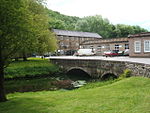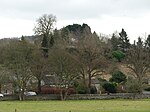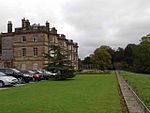Hassop railway station

Hassop railway station was a station situated about two miles from the village of Hassop in the Peak District of Derbyshire. It was opened in 1862 by the Midland Railway on its extension of the Manchester, Buxton, Matlock and Midlands Junction Railway from Rowsley.It was built for the benefit of the Duke of Devonshire of Chatsworth House who, having previously declined to allow the railway to pass over the easier terrain of his lands, belatedly saw its possible benefit. Indeed, for a while it was renamed "Hassop for Chatsworth". However, in this sparsely populated area, it saw little use, and closed in 1942. It greatest usefulness was as a goods yard, which closed in 1964. The station building has since been renovated by Hassop Station Ltd. Hassop Station is now a family friendly cafe with outdoor covered seating and play area, book shop, gift shop and cycle hire facility. Disabled access and toilets are available here, along with a large car park. The trackbed is part of the Monsal Trail, a walk and cycleway. Four tunnels (located between the Great Longstone station and Topley Pike Junction sites) were reopened on the trail in May 2011, lengthening the trail to a continuous 8.5 miles (13.7 km) for cyclists walkers and riders.
Excerpt from the Wikipedia article Hassop railway station (License: CC BY-SA 3.0, Authors, Images).Hassop railway station
Monsal Trail, Derbyshire Dales
Geographical coordinates (GPS) Address Phone number Website Nearby Places Show on map
Geographical coordinates (GPS)
| Latitude | Longitude |
|---|---|
| N 53.2312 ° | E -1.6758 ° |
Address
Peak eBikes
Monsal Trail
DE45 1NW Derbyshire Dales
England, United Kingdom
Open on Google Maps










